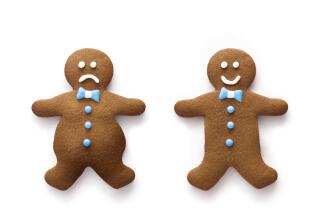It’s Time to Face Facts About Unhealthy Food Habits
- Share via
In last week’s column, I explained the dismay I feel every time I discover how many new products on store shelves promise to take the pounds or inches off without your having to do anything. Weight loss, apparently, is the one area in which everyone is still awaiting the magic bullet. Deep down, people must know that if they expect to lose weight, they have to change their eating and exercising habits. And yet they’re willing to believe in magic.
Even those who mean well often sabotage their weight-loss efforts. Whether unconsciously or unknowingly, they do things that undermine their best intentions, causing them usually to give up in frustration.
There are six common ways of self-sabotage. Last week I discussed the first three: setting unrealistic goals, focusing on weight instead of health, and miscalculating the importance of exercise. So now let’s get to the final three, all of which involve nutrition:
4. We put too much food on our plates.
This seems to be a uniquely American habit. In other countries, food servings at home and at restaurants are sufficient; here, they’re gargantuan. Unfortunately, feeling full lags about 20 minutes behind the stomach’s actually being full, so we end up overeating when there’s a lot of food on the plate. Study after study proves that people who are served big portions eat more than they otherwise would have. In other words, put less food on the plate and they leave the table satisfied, not stuffed.
*
The solution to gluttony? Here are a few suggestions. When you’re eating at home, only put the recommended portion on your plate. When you’re at a restaurant or having a meal at someone else’s house, try to eat the same amounts. How? In your mind, make associations between the recommended portion of foods with common objects. That way, you can stop when you should. For example, a 3- to 4-ounce serving of meat or fish is about the size of a deck of cards. One cup of cooked vegetables: a baseball. One ounce of bread: a sandwich-size slice. One ounce of cheese: a wine cork. One teaspoon of butter: about two-thirds of a standard butter pat. (Have some fun making up your own memory devices.)
5. We focus on fat, not calories.
When the nonfat food craze hit a few years ago, a lot of us misunderstood the reasoning behind eating nonfat foods. It was because fat is calorie-dense--that is, a small amount of it contains a lot of calories. But to this day, too many of us still believe you can eat as much zero-fat food as you want without gaining weight. If that were true, the obesity rates wouldn’t be rising so quickly. Nonfat foods are usually loaded with sugar, which is high in calories.
The key word is calories, not fat. In fact, researchers have discovered that people who eat primarily nonfat foods are just as likely to be overweight as those who include ordinary amounts of fat in their diets. And they may even be heavier.
Contrary to a stubborn myth, the amount of dietary fat in food does not automatically equate to fat on the thighs (or anywhere else); the amount of calories you ingest but don’t burn off does. A certain amount of fat in your food keeps you feeling full longer, so you snack less often.
6. Curb liquid calories.
A lot of people who don’t eat more than they should actually drink more than they should. It’s true. While overeating produces that full feeling, which keeps you from eating again for a while, drinking doesn’t have the same effect. Researchers have found that liquids don’t trigger your body’s satiety mechanism the way solid food does. So all those sodas, fruit juices, smoothies and alcoholic drinks that you ingest all day are simply added calories--often, in fact, a lot of them.
The idea is to find ways to refresh yourself and hydrate with liquids that are either no-cal or low-cal. In my book, nothing beats water.
So there you have them, the six most common ways we sabotage ourselves when it comes to weight loss. I hope that, if you’re serious about weight loss and getting fit, you’ll abandon magic bullets and adopt logic.
Copyright 1999 by Kathy Smith
Kathy Smith’s fitness column appears weekly in Health. Reader questions are welcome and can be sent to Kathy Smith, Health, Los Angeles Times, Times Mirror Square, Los Angeles, CA 90053. If your question is selected, you will receive a free copy of her new video, “Kickboxing Workout.” Please include your name, address and a daytime phone number with your question.
More to Read
Eat your way across L.A.
Get our weekly Tasting Notes newsletter for reviews, news and more.
You may occasionally receive promotional content from the Los Angeles Times.









